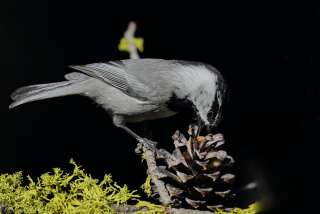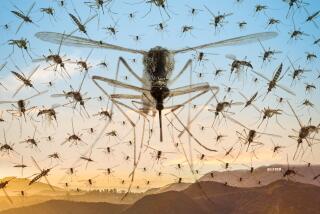Cicadas by the Billions Bug Residents of East : Return of 17-Year Noisemakers Has Capital Buzzing
WASHINGTON — The holes were the first sign: Dozens, hundreds of holes the size of dimes and quarters, scattered across urban gardens and suburban lawns. Then, strange tan hulls appeared, clinging to flowers and shrubs. Last week, the singing started.
Washington, which spent the early part of the spring joking about bugs in the U.S. Embassy in Moscow, now can talk about a bug of a different sort--with six legs and five red bulging eyes. Now that 17-year cicadas, Magicicada septendecim , have emerged once more across the East, the nation’s capital is literally abuzz.
Perhaps a-whine would be more accurate, or a-shriek. The cicada (pronounced sih-KAY-duh) is the world’s loudest insect, and as the insects surface by the billions from years of subterranean hibernation for a monthlong binge of molting and mating, they are creating a spectacle not easy to ignore.
Longest Incubation
The long-dormant insects are swarming into the trees, frenetically vibrating their tiny abdominal membranes like drumheads, to reproduce and renew their peculiar 17-year life cycle--the longest incubation known to science.
Nothing like it has been seen--or heard--since the midpoint of the first Richard M. Nixon Administration, when this cicada generation, after a similar one-month fling, bore into the earth to nurture themselves on tree roots and await this very moment.
With the return of a particularly large population here, a city of concrete and glass is beginning to resemble a tropical rain forest.
The air is filling with a swelling hum that threatens to drown out traffic, and the empty inch-long skins discarded by the molting bugs are hanging everywhere.
Cicadas are showing up in police reports. Wednesday, a delivery truck in suburban Arlington, Va., crashed into a utility pole and knocked out power to 50 homes after its driver was suddenly bashed in the face by an aerobatic cicada.
In Cincinnati, another cicada hot spot, “you can’t wear sandals outside because they crawl right onto your feet,” said June Alexander, a historian there.
Indeed, free speech--the capital city’s chief industry--seems to be in danger.
In 1970, the last time the cicadas appeared, “it got so loud that my neighbor and I couldn’t even conduct a conversation outside, and we had to go in the house to talk,” recalls Artemis Weiss, a housewife in the Washington suburb of Chevy Chase, Md.
Like ‘Low Motorboat’
“I remember in 1970, leaving the woods with a headache,” said Gaye L. Williams, an entomologist with the Maryland Department of Agriculture, who said the sound “reminds me of a low motorboat.”
And, like the birds in the Hitchcock horror movie, nothing can be done to stop them.
The cicada is “a unique phenomenon of nature,” said Sally Love, director of the Insect Zoo at the Smithsonian Institution here.
While there are other types of cicadas in the world--200 species in North America alone, including 3- and 13-year varieties--the type now emerging from southern New England to the Carolinas and west into the Plains “is the most extensive in space and the largest in number,” said Smithsonian entomologist Richard Froeschner.
Wiped Out by Suburbs
In some places, suburban development, which digs up buried cicada nymphs, has wiped out cicada populations. Here, however, “they are just countless,” Froeschner said.
When the mysterious 17-year time clock goes off, the insect’s ritual begins like a massive, synchronized military maneuver--backyard barbecues, picnics and camping trips notwithstanding.
Sits Till Wings Harden
Abandoning their underground root perches, they crawl to the nearest vertical object and molt. After leaving behind the clinging husk of its former skin, the cicada emerges pale white and soft and sits until its newly unfolded wings harden enough to fly.
The males busy themselves making a revving din that attracts females to mate. That accomplished, within two to four weeks, each female scratches a tiny slit in a twig and deposits 20 to 40 eggs and then dies. The eggs take six to eight weeks to hatch, at which point the tiny nymphs drop to the ground to begin the cycle again.
Tapping for Sap
“If they land on concrete, that’s the end of the story,” Williams said, “but if they land on the ground, they’ll dig in and find a rootlet” to feed on, using a mouth part shaped like a tiny soda straw to tap the root for sap.
The process is essentially harmless. Unlike locusts, with whom they are sometimes confused, cicadas do not chew leaves. They neither bite nor sting. Even the twig slits cause little damage.
And they provide entertainment for bored children awaiting summer vacation. In suburban Bethesda, Md., residents say that cicada collecting has become a prime hobby. One 6-year-old recently delighted her parents with an apparent interest in science when she gathered a shoe box full of newly hatched cicadas. Delight waned when she turned them loose for a walk across the living room floor.
Adults in general appear less than thrilled with the six-legged visitors. One woman reported taking out a broom to brush cicadas off her shrubs. “But then they started crawling up the broom,” she said with a shudder.
Too Many to Sweep
“My neighbor was upset,” Froeschner said. “He had scheduled a party for Memorial Day and gave up because he couldn’t sweep all the cicadas out of the yard. They kept coming faster than he could sweep.”
Entomologists are having a field day. In addition to getting to watch the unusual ritual, some, like Williams, are amusing themselves looking for the rarer specimens with orange or brown eyes, rather than the standard red. So far, Williams said, one has even turned up with gray eyes “like Lauren Bacall.”
And one of her colleagues, she said, has tried cicadas as a side dish, adding a little salt and garlic and frying them in butter. “A lot like tofu,” she said.
For most Washington residents, the cicadas mean mostly an unexpectedly early wake-up call. They need only have patience, however. By July 4, the sounds of backfiring buses and grinding garbage trucks will again be the music of the city. The cicadas will not return until May, 2004.
More to Read
Sign up for Essential California
The most important California stories and recommendations in your inbox every morning.
You may occasionally receive promotional content from the Los Angeles Times.











